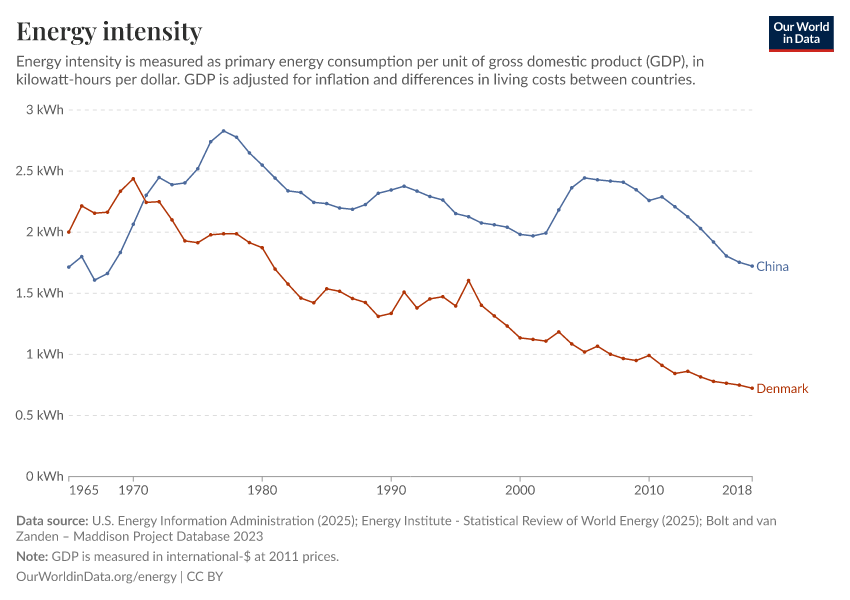Primary energy consumption per GDP

What you should know about this indicator
- The Maddison Project Database is based on the work of many researchers who have produced estimates of economic growth and population for individual countries. The full list of sources for this historical data is given in the original dataset.
- Gross domestic product (GDP) is a measure of the total value added from the production of goods and services in a country or region each year.
- This indicator provides information on economic growth and income levels in the very long run. Some country estimates are available as far back as 1 CE, and regional estimates as far back as 1820 CE.
- This data is adjusted for inflation and differences in living costs between countries.
- This data is expressed in international-$ at 2011 prices, using a combination of 2011 and 1990 PPPs for historical data.
- Time series for former countries and territories are calculated forward by estimating values based on their last official borders.
- For more regularly updated estimates of GDP per capita since 1990, see the World Bank's indicator.
Related research and writing
What you should know about this indicator
- The Maddison Project Database is based on the work of many researchers who have produced estimates of economic growth and population for individual countries. The full list of sources for this historical data is given in the original dataset.
- Gross domestic product (GDP) is a measure of the total value added from the production of goods and services in a country or region each year.
- This indicator provides information on economic growth and income levels in the very long run. Some country estimates are available as far back as 1 CE, and regional estimates as far back as 1820 CE.
- This data is adjusted for inflation and differences in living costs between countries.
- This data is expressed in international-$ at 2011 prices, using a combination of 2011 and 1990 PPPs for historical data.
- Time series for former countries and territories are calculated forward by estimating values based on their last official borders.
- For more regularly updated estimates of GDP per capita since 1990, see the World Bank's indicator.
Sources and processing
This data is based on the following sources
How we process data at Our World in Data
All data and visualizations on Our World in Data rely on data sourced from one or several original data providers. Preparing this original data involves several processing steps. Depending on the data, this can include standardizing country names and world region definitions, converting units, calculating derived indicators such as per capita measures, as well as adding or adapting metadata such as the name or the description given to an indicator.
At the link below you can find a detailed description of the structure of our data pipeline, including links to all the code used to prepare data across Our World in Data.
Notes on our processing step for this indicator
- Primary energy consumption data was compiled based on two key data sources: Energy Institute (EI) Statistical Review of World Energy, and International energy data from the U.S. Energy Information Administration (EIA). EI provides the longest and most up-to-date time-series of primary energy. However, it does not provide data for all countries. We have therefore supplemented this dataset with energy data from the EIA. Where EI provides data for a given country, this data is adopted; for countries where this data is missing, we rely on EIA energy figures.
- Per capita figures have been calculated using a population dataset that is based on different sources.
- To calculate energy per unit of GDP, we divide by total real GDP figures from the Maddison Project Database.
Reuse this work
- All data produced by third-party providers and made available by Our World in Data are subject to the license terms from the original providers. Our work would not be possible without the data providers we rely on, so we ask you to always cite them appropriately (see below). This is crucial to allow data providers to continue doing their work, enhancing, maintaining and updating valuable data.
- All data, visualizations, and code produced by Our World in Data are completely open access under the Creative Commons BY license. You have the permission to use, distribute, and reproduce these in any medium, provided the source and authors are credited.
Citations
How to cite this page
To cite this page overall, including any descriptions, FAQs or explanations of the data authored by Our World in Data, please use the following citation:
“Data Page: Primary energy consumption per GDP”, part of the following publication: Hannah Ritchie, Pablo Rosado, and Max Roser (2023) - “Energy”. Data adapted from U.S. Energy Information Administration, Energy Institute, Bolt and van Zanden. Retrieved from https://archive.ourworldindata.org/20251111-144738/grapher/energy-intensity.html [online resource] (archived on November 11, 2025).How to cite this data
In-line citationIf you have limited space (e.g. in data visualizations), you can use this abbreviated in-line citation:
U.S. Energy Information Administration (2025); Energy Institute - Statistical Review of World Energy (2025); Bolt and van Zanden – Maddison Project Database 2023 – with major processing by Our World in DataFull citation
U.S. Energy Information Administration (2025); Energy Institute - Statistical Review of World Energy (2025); Bolt and van Zanden – Maddison Project Database 2023 – with major processing by Our World in Data. “Primary energy consumption per GDP” [dataset]. U.S. Energy Information Administration, “International Energy Data”; Energy Institute, “Statistical Review of World Energy”; Bolt and van Zanden, “Maddison Project Database 2023” [original data]. Retrieved January 7, 2026 from https://archive.ourworldindata.org/20251111-144738/grapher/energy-intensity.html (archived on November 11, 2025).

